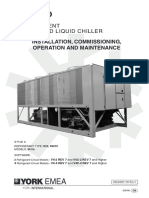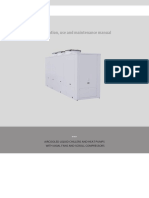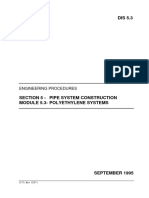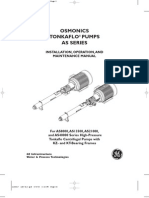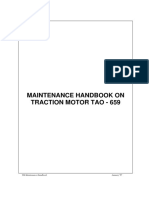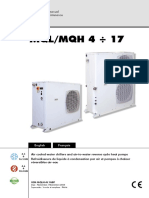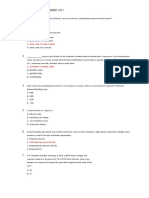Gen
Gen
Uploaded by
Juan Carlos PulidoCopyright:
Available Formats
Gen
Gen
Uploaded by
Juan Carlos PulidoCopyright
Available Formats
Share this document
Did you find this document useful?
Is this content inappropriate?
Copyright:
Available Formats
Gen
Gen
Uploaded by
Juan Carlos PulidoCopyright:
Available Formats
«» ••• 11&4: •••
PDOFIUAONAL DE
.NGI3NIEDIA. S.A. DE 4:.'''.
PROJECT No. 484
GAS COMPRESSION SERVICE IN CANTARELL AELD
CAMPECHE BAY
GENERAL PIPING SPECIACATION
ESP-c484- T-1000
REVISION CONTROL
APPROVED FOR
o 141MAYI99
CONSTRUCTION AGC
A 15 DIC 98 FOR APPROV AL AGC
REV DATE DESCRIPTION DESIGN APPROVE
SPECIAUTY
CLlENT APPROVAL (NAME & SIGNATURE) ISSUE DATE
CPI-CEC REV. 014 MAY.99
GENERAL PIPING SPECIFICA TION
COMPRESSION PLATFORM AKAL GC
ES P-c484-T-1 000
TABLE OF CONTENTS
PAGE No.
1.1GENERAL 3
1.2 ARRANGEMENTS 3
1.2.1 Dimensioning 3
1.2.2 Routing and Support 3
12.3 Accessibility 4
1.2.4 Flexibility 4
12.5 Blanking Stations 4
1.2.6 Miscellaneous Requirements 4
1.3CLEARANCES 5
1.4DESIGN DETAlLS 5
1.4.1 Minimum Pipe Wall Thickness 5
1.4.2 Line and connection Sizes 5
1.4.3 Bands and Reducers 6
1.4.4 Fit1ings and Flanges 6
1.4.5 Branch Connections 7
1.4.6 Valves 7
1.4.7 Gaskets 7
1.4.8 Bolting 8
14.9 Support. Anchors and GUldes 8
CPI-CEC REVO i4MAY.99
PAGE. 1 01 12
GENERAL PIPING SPECIFlCATION
COMPRESSION PLATFORM AKAL GC
ESP-C484- T -1000
1.5PROCESS UNES 8
1.6WATER UNES 9
1.7A1R UNES 9
.1.8CONTROL, REUEF ANO SPECIAL VAL VES 9
1.9INSTRUMENT CONNECnONS 10
1.10 ORAlNS ANO SEWER UNES 10
1.11 VENT ANO FLARE EXHAUST 11
1.12 HOT SURFACE INSULATION ANO ISOLATION 11
1.13 FIRE WATER PIPING 11
1.13.1 Distribution 11
1.13.2 Sprinkler and Water Spray System 12
1.13.3 Special Fire Protectioo Systems 12
CPI·CEC REV. o 14 MAY. 99
PAGE. 2 01 12
•• .•••• 11&0 ••
~I • FESI •• A.L BE
I.GE.IEal •. s.A.. DI3 C:.W.
GENERAL PIPING SPECIFICATION
COMPRESSION PLATFORM AKAL GC
ESP-c484-T·1000
1.1 GENERAL
In addition to the requirements ot this section and .the individual Piping Specitication
sheets (attached) the general design ot piping systems shall contorm to the appficable
sections ot the NACE Standard MR-01-75 and ASME B31.3 Code tor Pressure
Piping, hereinafter reterred to as the "Code".
The corrosion allowances tor the different services and classes are indicated in the
individual Piping Specification sheets
1.2 ARRANGEMENTS
1.2. 1 Dimensioning
A11piping drawings shaJI show dimensions in !he metric system, only the pipa size
(0) will be indicated in inches.
1.2.2 Routing and Support
AII piping shall be routed to provide neat and economical Layouts. with the
shortest possible runs and the mínimum number ot tittings consisten! with good
engineering practica. Piping, above and below ground, shall be run in plant North-
South and East-West directions, where possible, with adequate vertical clearance
between pipes crossing at right angles. Changes in direction shall generally be
accompanied by a change in elevation.
Pump suction lines from towers and receivers shall be routed to the pumps without
creating vapor traps in the line.
Wherever possible, all tinas shall be economically grouped and routed in parallel
at a common bottom ot pipa (BOP) elevation on overhead pipe supports. sleepers,
or in trenches. Clearance shall be allowed between fines to permit access for
removal and/or r repair, allowing a minimum ot 5O-mm (2-inches) between a pipe
and the largest f1ange or fit1ing of the adjacent pipe. Insulation thickness and
movement due to thermal expansion or contraction shall be considered when
determining pipa spacing and bottom elevatíon. The minimum space allowanee tor
future piping on pipe racks and sleepers shall be approximately 25 pareent.
Pipíng shall be supported as neeessary to prevent exeessive sagging. mechanical
stresses or vibrations. AII pipe supports. guides. clamps and anchors shall be as
specitied on the AFC drawings.
CPI·CEC REV. o 14 MAY. 99
PAGE. 30112
GENERAL PIPING SPECIFICA nON
COMPRESSION PLATFORM AKAL GC
ESP-C484-T-1000
1.2.3 Accessibility
The piping systems shall be arranged to prevent overhead or stumbling hazards in
designated access or walkway areas as well as interference with equipment
maintenance, removal, operation, or inspection. Where interference to equipment
removal cannot be avoided, and where so indicated on the Engineering and/or
Utility Flow Diagrams, removable spool pieces shall be provided.
AII valve manifolds, control vaNes, and motor valves shall be lacatad to provide
easy accessibility tor operation and repair.
Control valves and adjacent piping shall be arranged and supported so that the
valves can be removed without disturbing the operating systems or supports.
Sufficient c1earance shall be left above or below control valves to permit removal
ot related andlor adjacent bypass and block valves.
1.2.4 Rexibility
The use ot cold spring, expansion bends and loops or other approved means shall
prevent excessive stress Í'l the piping systems due lo expansion or contraction.
Piping systems shall be designed so that torees on equipment due to static or
operating loads, including those produced by expansion, shall not exceed the
allowable torees or cause misaJignments greater than permitted by the equipment
manufacturers.
1.2.5 Blanking Stations
Lines, except water and air lines, shall have consolidated blanking stations outside
the battery limits ot each area. The stations shall include permanent access
platforms and ladders. The lines shall each have a block valve and a bleed valve
at the battery limits, with the blanking point installed on the area side ot the block
valve. Flare lines shall be provided with valves, which are locked open at these
blanking stations. Where such valves are present in horizontal flare lines, they
shall be installed in positions that will prevent unintentional c10sing due to
vibration.
1.2.6 Miscellaneous Requirements
Insulating flange gasket sets shall be installed between oHshore pipeline risers·
and platforms, and between underground and aboveground lines.
Temporary startup strainers shall be installed in suction tines to all major rotating
equipment (compressors, pumps, etc.) lor removal 01 loreign materials. Piping
CPI-CEC REV. o 14 MAY. 99
PAGE. 4 01 12
GENERAL PIPING SPECIFlCATION
COMPRESSION PLATFORM AKAL GC
ESP-c484-T-1000
shall be arranged so those temporary strainers can be removed without disturbing
adjoining piping or supports.
The high and low points of all tines shall be provided with ~" minimum vent and
drain connections, which may be plugged if required only for startup or valved if
required during normal operation.
1.3 CLEARANCES
Minimum clear headroom for all overhead pipeways on offshore platforms shall be 7'-
6". Other clearances shall be provided lo accommodate the applicable requirements
of Subsection 1.2 above.
Access for operation and maintenance shall be provided from both sides of pumps.
compressors, control valves, etc., and otherwise to accommodate applicable
requirements of Subsection 1.2 above.
1.4 DESIGN DET AlLS
1.4.1 Minimum Pipe Wall Thickness
The miniml6Tl pipa wall thickness shall be the greater of stated thickness or the
calculated thicknesses for the pressure and temperature rating of the piping,
taking into consideration hoop stress, corrosion allowance, manufacturing
tolerance, and thread a1lowance as applicable.
Low carbon steel pipes 1-1/2" nominal diameter and smaller shall be Schedule
80 minimum, except for sprinkler and water spray systems. Nominal diameters 2"
through 10" shall be Schedule 40 minimum, añd 12" and larger shall be the
minimum indicated on the applicable individual Specification sheets. Minimum
wall thickness for all other pipe materials shall be calculated. and shall be in full
accordance with "Code" requirements.
AII pipa nipples ~ •• diameter and smaller shall be Schedule 160 seamless
mínimum for hydrocarbon service. and Schedule 80 for all other services.
1.4.2 Líne and Connection Sizes
Pipe smaller than :y.." shall not be usad except for instrument connections and for
air connections to control valves.
Líne sizes 1-1/4", 3-1/2", and the odd numbered sizes larger than 3-inch shall not
generally be used. Exceptions may be made for companion connections to
equipment, and where economics in the use of costly piping materials is a
controlling factor.
CPI·CEC REY. o 14 MAY. 99
PAGE. 5 of 12
GENERAL PIPING SPECIFICATION
COMPRESSION PLATFORM AKAL GC
ESP-C484-T·1000
Une sizing tor tire protection systems shall be in accordance with NFPA
Standards 13, 15, and 24.
1.4.3 Bends and Reducers
Piping shall be designed wtth either bends or long radius welding elbows. The
use ot short radius weld ells shall be kept lo a minimum.
Only reducing tittings shall make changes in line sizes, sockel weld inserts,
reducers, or swages. No bushings shall be used. The larger line schedule shall
determine the fitting wall thickness, ¡.e. a butt weld fitting connecting 4" Schedule
40 and 2" Schedule 80 lines shall be purchased as a 4" X 2" Schedule 80
reducer wilh the 4" end taper bored lo Schedule 40.
Reducing elbow shall be used only where required tor clearance purposes.
1.4.4 Fittings and Flanges
The dimensions of al! steel fittings 36-, larger and smaller shall conform to ASME
Standard B16.9. The dimension ot steel tlanges 24" and smaller shall contorm to
ASME Standard B16.5. Steel flanges larger than 24" shall contorm to ASME
Standard 816.47 series A.
Special tittings shall not be used except where standard tittings cannot be
employed.
Bull plugs 1" and smaller shall be solid steel plugs, and shall be long enough to
ex1end Ihrough insulation.
Flanges tor all services shall be as noted under individual Piping Specification
sheets.
Whenever flat faca cast ¡ron flanged fittings and valves are usad in utility piping,
the steel companion f1anges shall be flat faces, and full-tace gaskets shall be
S~vi.t
used. Flanges shall be flat tace where connecting to tlat tace pump, turbine, rJ b-{ \:)
compressor, or other equipment nozzles. Their use should be minimizad and \J. cj3.V'
discouraged. -------------------------
------=-----
Slip-on flanges may be substituted tor weld neck tlanges only where required to
suit space Iímitations.
Threaded fittings shall have threads conforming lo ASME Standard B2.1.
Where socket weld valves or fittings are used, the pipe shall be spaced in the
socket so that no stress es will be imparted to the weld due to bottoming ot the
pipe in the socket.
CPI-CEC REV. O 14 MAY. 99
PAGE. 601 12
ce."IIA~ •• N GENERAL PIPING SPECIFICATION
COMPRESSION PLATFORM AKAL GC
ESP-C484- T-1000
Spectacle blinds. rather than spade-type blinds. shall be provided when space
permits. The thickness ot blinds shall be calculated in accordance with API - 590.
Jackscrews shall be provided as required.
1.4.5 Branch Connections
Branch connections shall be made in accordance with the charts in the
applicable individual Piping Specification sheets. The pipe schedule of a branch
must be at least as great as that tor the header.
Where thredolets, sockolets, socket weld coupling are used, they shall be a
minimum ot 3000#.
1.4.6 Valves
A11valves usad in sour hydrocarbon sarvies shall contorm to NACE Standard
MR-Q1-75.
Except tor buttertly and water check valves, face to tace dimensions of tlanged
valves shall contorm to ASME Standard B16.10. FIanges on al! steel valves 24-
inch and smaller shall contorm to ANSI Standard B16.5. Flanges on steel va/ves
larger than 24-inch shall conform to ASME B16.47 series A.
Globe valves shall be used only where throttling is required. Valves operated in
wide open and block-in service shall be gate, plug, and buttertly or ball type as
required for product and service.
Manually operated valves located more than 2.1 m (T-O") above platforms, f100rs
shall be provided with impact type chainwheels and chains. The bottom of chains
for handwheels shall clear operating levels by 1.4 m (4'-0"), and shall not
obstruct passageways. Chainwheel operators shall not be usad on valve 2" and
smaller.
AII tire water control and block valves shall be the indicating types.
The tirst process valve from any piping header, vessel vent, drain etc. shall be a
minimum of :Y4".
AII tank valves, which are used for tank block service and are, located next lo the
tank, shall be Ihe gate flex-wedge type with bottom taps.
1.4.7 Gaskets
Gaskels shall be 01 the type specilied on the individual Piping Specilication
sheets.
CPI-cEC REV. o 14 MAY. 99
PAGE. 70112
GENERAL PIPING SPECIFICATION
COMPRESSION PLA TFORM AKAL GC
ESP-c484- T-1 000
1.4.8 Bolting
A11 bolting used in sour hydrocarbon serviee shall eontorm to NACE Standard
MR-01-75.
Minimum bolting materials shall be ASTM A 193, Grade B7M, and nuts shall be
ASTM A 194, Grade 2M.
1.4.9 Support, Anehors and Guides
Supporting systems and components shall be property proportioned and
designad to provide adequate support tor all piping. Suitable anehors, guides
andlor eold springing provisions shall be made to prevent exeessive stresses
due to expansion, eontraction, or vibration. Supports shall be designed assuming
that alllines will be tilled with water tor hydrotesting.
In general, an piping shan be carried directty en sfructural supports, rather than
hung with rods. Rod hangers, where used, shall not be less than 3/8" diameter
tor any size lines.
Piping shal! not be directty weaded lo supports. Insulation on piping shaJl De
protectad at support points by saddles or suitable steel shoes attached to the
pipe. Attaehments welded to the pipe tor supports, guides, anehors, ete. shall be
fabricatad from materia! compatible with the pipa. Welding shaJl be in
accordanee with the appropriate welding procedures.
Piping entering vessels shaJl preterably be supported from braekets attaehed to
adjaeent steelwork rather than to the vessel.
1.5 PROCESS UNES
AII pipes in contaet with sour hydrocarbon serviee shall eonform to NACE Standard
MR-Q1-75.
1" sample eonnections shall be provided as shown on the Engineering andlor Utility
Flow Diagrams.
Serewed eonnections, exeluding those lor instrument and equipment eonnections.
shall be socket weld in hydrocarbon serviee, where so indieated on the individual
Piping Speeilieations sheets.
Unions shall be kept to a minimum in hydrocarbon servies.
CPI-CEC REY. o 14 MAY. 99
PAGE 8 of 12
II! ••••••• .:••• GENERAL PIPING SPECIFlCATION
~I .B FES••• AIL DE
•• GE•• E •• A. !LA. E ':.Y.
COMPRESSION PLATFORM AKAL GC
ESP-C484·T-1000
1.6 WATER UNES
Potable and salt-water utility lines shall be routed above platform decks when
practica!. Potable water mains may be routed below ground.
Hose connections 01 ~" size, with globe valve, shall be provided such that all working
areas may be reached with a So-foot length of hose.
1.7 AlR UNES
Service air systems shall be provided to supply air for maintenance tools, cleaning,
emergency use, ete.
Hose eonnections 01 ~" size, with globe valve, shall be provided sueh that all working
areas may be reached with a 5O-foot length of hose.
Instrument air supply headers shall be a minimum of 1-1/2-ineh. Loeation and size 01
lines from headers to instruments shall be as indicated on the Instrument Orawings.
1.8 CONTROL. REUEF ANO SPECIAL V AL VES
AII valves used in sour hydrocarbon serviee shall conform to NACE Standard MR-01-
75.
Control, relief and special valves shall be provided as indicated on the Engineering
and/or Utility -Flow Oiagrams, P&IO's.
Bleed valves shall be provided at control valves when the line content is toxic.
Block valves with Iocking devices shall be installed upstream 01 relief valves to
facilitate valve maintenance.
A bleed valve shall be installed between each block valve and safety valve.
Safety valves discharging into a closed header shall be arranged so that the
discharge pipe enters above the header eenter line to prevent trapping liquids in the
tail pipa.
Safety and thermal relief valves shall be removed or blanked off during piping system
hydrostatic tests. Pilat operated safety reliel valves shall be blinded on the inlet side
or removed.
CPI-CEC REY. o 14 MAY. 99
PAGE. 901 12
GENERAL PIPING SPECIFICATlON
COMPRESSION PLATFORM AKAL GC
ESP-C484- T-1ooo
1.9INSTRUMENT CONNECTIONS
Instrument connections shall be provided as required in the Standard Instrument
Specifications, or as indicated on the Instrument Drawings.
AII service pressure gauge connections shall be ~" National Pipe Thread (NPT).
AII sarvice temperature connections shall be 1" National Pipe Thread (NPT).
Connections for pressure or flow instruments shall have a block valve at the header or
vessel. Instrument bridles shall have block valves at the vessel.
1.10 DRAlNS ANO SEWER UNES
Operational low point draíns in process service shall be piped to a closed drain
system. Each line shall include an 1"minimum block valve.
An oily water sewer shall be provided to collect drainage from floor drains, pump
bedplates and other sources of oíl contaminated water. A vented, closed process
sewer shall be installed lo provide a safe means for disposing of f1ashing waste and
for draining all equipment in emergencies or for repairs.
G ravity flow drain and sewer Iines shall be sloped not less than one percent (1 %) in
the pipe header areas, and shall not be smaller than 4" diameter. Discontinuities in
line slopes, such as slope changes or inverted siphons (sags), shall be avoided, if at
all possible.
AII branches shall be coonected to mains at an angle of 45 with a minimum slope of
one percent (1%).
AII equipment and floor drains shall have traps or other means to prevent back flow of
gases.
Clean outs shall be provided for sewer lines and open drain lines at 50-foot intervals.
AII open drains shall be laid out so that all branches and mains can be cleaned, and
so that no equipment need be removed in the event of drain repairs. The drains shall
be piped ¡nto sumps below the liquid level.
Consideration shall be given to expected rainfall in establishing the design capacity 01
drain systems.
CPI-CEC REY. o 14 MAY. 99
PAGE. 10 of 12
",1 " INGENIE
at."IIA~I.N
• FE511 NAL DE
lA. S.A. DE ~.Y.
GENERAL PIPING SPECIFICATION
COMPRESSION PLATFORM AKAL GC
ESP-C484-T-1000
1.11 VENT ANO FLARE EXHAUST
Vent header piping shall be arranged to avoid pockets where Iiquids may accumulate.
Headers shall be designed with a mínimum one-pereent (1%) slope to the flare drum.
Operational high point vents in process serviee shall be piped to a process vent
header. Eaeh line shall inelude a 1" minimum block valve.
Provisíons shall be made for steaming out anci/or gas purging vents and flare lines
trom the extremities.
1.12 HOT SURFACE INSULATION ANO ISOLATION
Insulation 01 process piping shall be in accordanee with the Standard Insulation
Specifications. unless otherwise indieated herein.
Slnaces normally accessible to personnel, and with operating temperaturas greater
than 158 °F (70°C), shall be insulated.
A11surfaees with operating temperatures greater than 400°F (204 0c) shall be
RsuIated, if accessible by combustible hydrocarbons.
A11piping far heat transfer media shall be insulated.
1.13 ARE WATER PIPING
A11piping materials. fittings. valves. hydrants and special eomponents shall be
Underwriters Laboratories. Ine. (UL) or Faetory Mutual (FM) listed for fire protection
service. These materials/components shall be as indicated on the individual Piping
Specifieation sheets.
The design, arrangement and installation of the distnbution mains shall be in
accordance with NFPA Standard 24. The mains shall be looped for reliability, where
practica!.
The sizes of distribution mains and laterals shall be calculated to provide the flow
rates and pressures required.
1.13.1 Distribution
For offshore installation. where distribution mains are normally charged with
saltwater, an allowance for eorrosion shall be made.
For feeds to sprinkler and water spray systems. the transition between the
distribution piping and the system piping shall be at the lace 01 the discharge
flange of the system block valve.
CPl-CEC REY. o 14 MAY. 99
PAGE. 11 of 12
GENERAL PIPING SPECIFICA TION
COMPRESSION PLATFORM AKAL GC
ESP-C484- T-1000
1.13.2 Sprinkler and Water Spray System
Piping System designs and arrangements shall be in accordance with NFPA
Standards 13 and 15, as applicable.
Wet pipa sprinkler systems, utilizing saltwater, shall normally be charged with
tresh water, or shall be provided with an adequate corrosion allowance.
1.13.3 Special Fire Protection Systems
Piping tor special tire protection systems, such as CO2• dry chemical, and foam
concentrate, are excluded trom these Standards. Piping materials for such
systems shall be covered in separate system specifications.
REV. o 14 MAY. 99
CPI-CEC PAGE. 120112
You might also like
- YORK Chiller Complete Manual 200 TonsDocument84 pagesYORK Chiller Complete Manual 200 TonsRijaa Arshad100% (1)
- Manual IMEXUS 28Document35 pagesManual IMEXUS 28polidorosNo ratings yet
- METHOD STATEMENT FOR TOILET (Temporary) CONSTn.23.3.23Document21 pagesMETHOD STATEMENT FOR TOILET (Temporary) CONSTn.23.3.23vinayp talpada100% (1)
- YAEP - Manualzz York ChillerDocument60 pagesYAEP - Manualzz York Chillerashfaq khan100% (4)
- Crane SWF 5 Ton Manual Book PDFDocument28 pagesCrane SWF 5 Ton Manual Book PDFAnggit67% (3)
- Installation, Use and Maintenance Manual: Aircooled Liquid Chillers and Heat Pumps With Axial Fans and Scroll CompressorsDocument32 pagesInstallation, Use and Maintenance Manual: Aircooled Liquid Chillers and Heat Pumps With Axial Fans and Scroll CompressorsGigi M.100% (2)
- SDCS-01: Saudi Electricity CompanyDocument30 pagesSDCS-01: Saudi Electricity Companyessam khalilNo ratings yet
- Manual de Partes Komatsu 930E AFE48-U (INDONESIA) PDFDocument460 pagesManual de Partes Komatsu 930E AFE48-U (INDONESIA) PDFAnonymous HhjNxRCS6A100% (6)
- RWC RWR BassaDocument192 pagesRWC RWR Bassaapi-3769211No ratings yet
- Installation, Service, Maintenance and Repair Manual: 1 of 35 Issue/ModDocument35 pagesInstallation, Service, Maintenance and Repair Manual: 1 of 35 Issue/ModAntonio MartinNo ratings yet
- Pump Sizing Calculation SheetDocument7 pagesPump Sizing Calculation Sheetvofaith100% (3)
- K0000-22 EngDocument28 pagesK0000-22 Engali hamzaNo ratings yet
- ,åtgfjt: Kuwait EngíneeríngDocument26 pages,åtgfjt: Kuwait Engíneeríngvignesh558855No ratings yet
- Service Manual For Fire Boss At-802 Conversion On Wipline 10000 Model FloatsDocument87 pagesService Manual For Fire Boss At-802 Conversion On Wipline 10000 Model FloatsemanuelNo ratings yet
- 2 X 160 MW Çan Thermal Power PlantDocument41 pages2 X 160 MW Çan Thermal Power PlantAlien EnergyNo ratings yet
- UntitledDocument32 pagesUntitledAmir AbazaNo ratings yet
- Static Equipment ErectionDocument17 pagesStatic Equipment Erectiononur gunes100% (2)
- K0000 05 EngDocument25 pagesK0000 05 Engali hamzaNo ratings yet
- National Oil Corporation: Rev Date Description Checked ApprovedDocument38 pagesNational Oil Corporation: Rev Date Description Checked ApprovedRochdi SahliNo ratings yet
- Rc6 Product InformationDocument66 pagesRc6 Product InformationDilip SarawgiNo ratings yet
- National Oil Corporation: Rev Date Description Checked ApprovedDocument18 pagesNational Oil Corporation: Rev Date Description Checked ApprovedYousab JacobNo ratings yet
- KX FT72BR GDocument163 pagesKX FT72BR GEduardo HernandesNo ratings yet
- Dry Dock Specification CopiarDocument201 pagesDry Dock Specification CopiarAngel Javier Valhondo LindertNo ratings yet
- National Oil Corporation: Rev Date Description Checked ApprovedDocument29 pagesNational Oil Corporation: Rev Date Description Checked ApprovedRochdi SahliNo ratings yet
- 10481-BCL-AKSX-ME-SPC-0002 - A0 - AFC Specification For Pig Launcher & ReceiverDocument22 pages10481-BCL-AKSX-ME-SPC-0002 - A0 - AFC Specification For Pig Launcher & Receiverchukudi oguneNo ratings yet
- DIS 5.3 PE MainlayingDocument51 pagesDIS 5.3 PE MainlayingAshraf Ismail HassenNo ratings yet
- 10481-BCL-AKPL-PE-SPC-0006 - A1 - AFC - Specification For Pipeline Underground Warning TapeDocument14 pages10481-BCL-AKPL-PE-SPC-0006 - A1 - AFC - Specification For Pipeline Underground Warning TapeJoseph EgonaNo ratings yet
- KX-FT21 PC+SM PDFDocument166 pagesKX-FT21 PC+SM PDFMārtiņš DreijersNo ratings yet
- ALLEN BUCKET ELEVATORS MANUAL REV 7 - sm1087Document30 pagesALLEN BUCKET ELEVATORS MANUAL REV 7 - sm1087Saman GhafaeiNo ratings yet
- Decca Window WiperDocument32 pagesDecca Window Wipertm5u2rNo ratings yet
- MGP2-GEN-KBR-IN-7739-0008_002Document21 pagesMGP2-GEN-KBR-IN-7739-0008_002sachin.chandNo ratings yet
- MarquadtDocument54 pagesMarquadtSamarth GujratiNo ratings yet
- K0000 04 EngDocument31 pagesK0000 04 Engali hamzaNo ratings yet
- Electrical InstallationDocument60 pagesElectrical Installationonur gunes100% (1)
- Installation Use and Maintenance: Cooling-Only, Heat Pump and Free-Cooling VersionsDocument64 pagesInstallation Use and Maintenance: Cooling-Only, Heat Pump and Free-Cooling VersionsВасилий КонстантиновNo ratings yet
- (MEC.2) 912IP0032700 - AIR-FLUE GAS Damper SpecificationDocument16 pages(MEC.2) 912IP0032700 - AIR-FLUE GAS Damper SpecificationrezaNo ratings yet
- QP-SPC-R-010-1 - 1 - Welding Procedures PDFDocument40 pagesQP-SPC-R-010-1 - 1 - Welding Procedures PDFMohamed100% (1)
- ENI - Drilling Procedures ManualDocument234 pagesENI - Drilling Procedures Manualmartialsalomon9No ratings yet
- General Specification For Main Laying ContractsDocument40 pagesGeneral Specification For Main Laying ContractsMHD SHAERNo ratings yet
- Sched-F2-OHL Design 20kV LinesDocument24 pagesSched-F2-OHL Design 20kV LinesyvNo ratings yet
- National Oil Corporation: Rev Date Description Checked ApprovedDocument22 pagesNational Oil Corporation: Rev Date Description Checked ApprovedRochdi Sahli100% (1)
- Aspak: YCSE040-YCSE100 & YCRE040-YCRE100Document68 pagesAspak: YCSE040-YCSE100 & YCRE040-YCRE100ГОРОД КЛИМАТАNo ratings yet
- Mtbe Online Operating ManualDocument219 pagesMtbe Online Operating ManualAmit Singh100% (2)
- DIS 5.10 Service LayingDocument76 pagesDIS 5.10 Service LayingAshraf Ismail HassenNo ratings yet
- Kocmv007field Erected Storage TanksDocument73 pagesKocmv007field Erected Storage TanksABDELKADER BENABDALLAHNo ratings yet
- EGP3-03.04 Piping Layout, Support and FlexibilityDocument59 pagesEGP3-03.04 Piping Layout, Support and FlexibilityMathias OnosemuodeNo ratings yet
- Manual - AS8000-40K - KDocument48 pagesManual - AS8000-40K - Kpersonal75No ratings yet
- Dilatometer USGS PDFDocument160 pagesDilatometer USGS PDFhendrawanNo ratings yet
- 6.1.7 Electrical Heat Tracing SpecificationDocument16 pages6.1.7 Electrical Heat Tracing SpecificationMohamed FaroukNo ratings yet
- Es321 Pole Mounted Distribution Transformers Issue 10Document29 pagesEs321 Pole Mounted Distribution Transformers Issue 10Anley NigissieNo ratings yet
- Maintenance Handbook For Traction Motor TAO-659 PDFDocument45 pagesMaintenance Handbook For Traction Motor TAO-659 PDFsumitNo ratings yet
- Clarke Manual PLD C131042Document13 pagesClarke Manual PLD C131042zona amrullohNo ratings yet
- 005 enDocument64 pages005 ensam tariqNo ratings yet
- Drainage Specs - Subission R0Document19 pagesDrainage Specs - Subission R0ErSoravNo ratings yet
- 20 01 BRGA PIP CAL VDR 0101 001 - Piping Flexibility Calculation and Analysis - R1 AFC (APPROVED)Document122 pages20 01 BRGA PIP CAL VDR 0101 001 - Piping Flexibility Calculation and Analysis - R1 AFC (APPROVED)Dheska AgungwNo ratings yet
- Construction Specifications: SincorDocument49 pagesConstruction Specifications: SincorcarlosNo ratings yet
- Desmi: Operating InstructionsDocument40 pagesDesmi: Operating Instructionsa.amangazinov1995No ratings yet
- 8401 enDocument32 pages8401 enSLAMET PAMBUDINo ratings yet
- National Oil Corporation: Rev Date Description Checked ApprovedDocument34 pagesNational Oil Corporation: Rev Date Description Checked ApprovedYousab JacobNo ratings yet
- Airwell MQH12 IOM MQLH N 1GB InstallationDocument40 pagesAirwell MQH12 IOM MQLH N 1GB InstallationMohammad dadkhahNo ratings yet
- Principles and Applications of Thermal AnalysisFrom EverandPrinciples and Applications of Thermal AnalysisPaul GabbottRating: 4 out of 5 stars4/5 (1)
- 5/2 Internal Pilot Operated, Poppet Type, Namur, Solenoid ValveDocument1 page5/2 Internal Pilot Operated, Poppet Type, Namur, Solenoid Valvemohan babuNo ratings yet
- Supplier Categories ListDocument5 pagesSupplier Categories ListShruti ChohanNo ratings yet
- Control Valve Working, Components & TypesDocument4 pagesControl Valve Working, Components & TypesHeri Fadli SinagaNo ratings yet
- Mech System Design GuideDocument43 pagesMech System Design Guideمعين عزامNo ratings yet
- Pipe Flow ProblemsDocument9 pagesPipe Flow Problemsadharb21No ratings yet
- Water Supplies Department: (7) in WSD 3318/50 Pt. 9 2829 4355 2824 0578Document6 pagesWater Supplies Department: (7) in WSD 3318/50 Pt. 9 2829 4355 2824 0578kumshing88cwNo ratings yet
- Flange Bolting Chart - Texas FlangeDocument5 pagesFlange Bolting Chart - Texas Flangesam.tragsNo ratings yet
- Automatic Float Control ValveDocument2 pagesAutomatic Float Control ValveMohamed Raafat100% (1)
- Specifications: Project: Proposed Two (2) Storey Residential Location: OwnerDocument4 pagesSpecifications: Project: Proposed Two (2) Storey Residential Location: OwnerJ.P.Almera ArDesignNo ratings yet
- 12 Pipe SizingDocument27 pages12 Pipe SizingVijay RajaindranNo ratings yet
- Plumbing Final Pre-BoradDocument12 pagesPlumbing Final Pre-BoradVholts Villa Vitug75% (8)
- SAES-R-004 Sanitary SewersDocument27 pagesSAES-R-004 Sanitary SewersWaqar AhmedNo ratings yet
- Major Works Design Technical GuidelineSep19 v17Document63 pagesMajor Works Design Technical GuidelineSep19 v17MAHESH CHANDNo ratings yet
- Osborne Reynolds ExperimentDocument7 pagesOsborne Reynolds ExperimentMarNo ratings yet
- Tolleranze Dimensionali A Norme ASME B16.9Document1 pageTolleranze Dimensionali A Norme ASME B16.9Emirhan PayNo ratings yet
- NBCP Building Systems DesignDocument55 pagesNBCP Building Systems DesignJainnah HadloconNo ratings yet
- Ermeti 2019Document88 pagesErmeti 2019Feiervari LeviNo ratings yet
- Imbinari Tevi Tyco-GrinnelDocument41 pagesImbinari Tevi Tyco-GrinnelSorin StanNo ratings yet
- Stainless Steel Pipes Dimension (Schedule, Wall Tickness & Weight)Document1 pageStainless Steel Pipes Dimension (Schedule, Wall Tickness & Weight)Senthil KumarNo ratings yet
- 06 Handout 1Document12 pages06 Handout 1Aienn EscobarNo ratings yet
- Enquiry - ValvesDocument6 pagesEnquiry - Valvesrkpatel40No ratings yet
- MFL67851408 - Rev. 05Document57 pagesMFL67851408 - Rev. 05hamze.johnmichael0% (1)
- 2 Catalouge-1 PDFDocument43 pages2 Catalouge-1 PDFArif TandraNo ratings yet
- OneSteel SS Pipe and Fittings Catalogue WebDocument24 pagesOneSteel SS Pipe and Fittings Catalogue WebAbramiuc MaraNo ratings yet
- Splbe - Master Plumber 2015: C. SinksDocument31 pagesSplbe - Master Plumber 2015: C. SinksXDXDXD100% (2)
- A Series LMI Roytronic Manual PDFDocument40 pagesA Series LMI Roytronic Manual PDFChris SmithNo ratings yet
- Documentos FisherDocument8 pagesDocumentos FisherErnestoNo ratings yet



